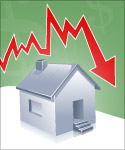Have you ever felt that sudden lurch in your stomach when something unexpected happens? That's kind of how the stock market felt on April 4, 2025, when the S&P 500 suffered its worst 6% collapse since March 2020. This wasn't just a minor dip; it was a significant jolt that sent ripples of concern through the financial world. To put it simply, the S&P 500, a key measure of U.S. stock market health, took a big hit, the largest single-day drop in over five years, primarily due to escalating trade tensions sparked by new tariff policies.
S&P 500 Plunges 6% in Biggest Fall Since 2020 Amid Trade War Fears
Let's rewind to that day. It wasn't as if the market was completely calm beforehand. There was already a sense of unease, and the previous day had seen a nearly 5% decline. But what happened on April 4th felt like a punch to the gut. The S&P 500 closed at 5,074.08, a stark contrast to its recent highs. This 6% drop, representing a loss of over 320 points in a single day, immediately brought back memories of the volatile period at the start of the COVID-19 pandemic. It was a day where headlines screamed of a “bloodbath on Wall Street,” and the sheer scale of the decline was hard to ignore.
The Spark: Tariffs and Retaliation
So, what lit this fuse? From what I've gathered, the primary catalyst appears to be the announcement of new tariff policies by then-President Donald Trump. These weren't small adjustments; we're talking about a proposed universal 10% tariff on all imports. On top of that, there were talks of even higher “reciprocal tariffs” aimed at countries with significant trade deficits with the U.S. This announcement, made just a couple of days prior, had already started to create ripples of worry.
But the real escalation came when China decided to respond, and they didn't hold back. The news of China imposing a hefty 34% tariff on all U.S. imports, set to take effect just a few days later, sent shockwaves through the market. This tit-for-tat action immediately raised fears of a full-blown global trade war. And as anyone who's followed economics knows, trade wars are rarely good for anyone. They can lead to higher costs for businesses, increased prices for consumers, and overall economic uncertainty.
The Domino Effect: How Different Parts of the Market Reacted
It wasn't just the S&P 500 that felt the pain. The Dow Jones Industrial Average also took a significant tumble, dropping by around 5.5%. And perhaps even more concerning was the NASDAQ Composite, which fell by nearly 6% and officially entered what's known as a bear market. A bear market is when a major stock market index experiences a decline of 20% or more from its recent high – a clear sign that investors are feeling pessimistic and pulling back.
Looking deeper, it became clear that certain sectors were hit harder than others. Companies with significant business ties to China, particularly in the technology and consumer goods sectors, saw substantial losses. Think about it: higher tariffs mean increased costs for importing goods, disrupted supply chains, and potentially lower demand as prices go up. For companies heavily reliant on these international connections, the future suddenly looked a lot more uncertain. I remember seeing reports of companies like GE HealthCare, which has a notable sales presence in China, experiencing particularly sharp declines. This makes sense, as investors would naturally be concerned about the impact of these tariffs on their bottom line.
Echoes of the Past: Context is Key
When we talk about the S&P 500 suffers worst 6% collapse since 2020, the “since 2020” part is crucial. March 2020 was a period of intense market turmoil at the onset of the COVID-19 pandemic. We saw some truly massive single-day drops back then, with the S&P 500 experiencing declines of almost 12% and 9.5% on separate days. So, while a 6% drop is significant, it's important to remember the context of those unprecedented times.
However, even when compared to other periods, a two-day decline of around 10.5% is nothing to sneeze at. It represents a substantial amount of wealth being erased from the market in a very short period. What makes this recent drop particularly impactful is that it came after a period where the market had been performing relatively well, even reaching near-record highs just before the tariffs were announced. This sudden reversal can be quite unsettling for investors.
What the Experts Were Saying (and What I Think)
Naturally, after such a significant market event, everyone wanted to know what the experts thought. And as you might expect, opinions were somewhat divided. Some analysts suggested that if the trade tensions were to ease quickly, we might see a market rebound. Historically, we've seen instances where market pullbacks are followed by periods of recovery.
However, there was also a significant contingent of experts expressing serious concern. The possibility of prolonged market volatility and even a potential recession started to enter the conversation. When you have major economies imposing significant tariffs on each other, it creates a climate of uncertainty that can stifle investment and economic growth. I personally felt that the speed and scale of China's retaliation were particularly worrying, signaling a potentially protracted standoff.
One economist I follow closely, Mohamed El-Erian, even highlighted that the “risk of a US recession is now uncomfortably high” in light of these developments. Federal Reserve Chair Jerome Powell also acknowledged that the tariffs were “larger than expected” and could lead to increased inflation and slower growth, potentially complicating the Fed's ability to cut interest rates. This is a critical point because interest rate policies can have a significant impact on market conditions.
Some analysts even tried to quantify the potential impact on corporate earnings. For example, there were estimates suggesting that S&P 500 earnings per share could decline by 2-3% due to these tariffs, with further tariff increases potentially leading to even larger earnings reductions. This kind of analysis helps investors understand the real-world consequences of these trade policies on the companies they invest in.
Looking Ahead: Uncertainty Reigns
As I sit here reflecting on this event, the future still feels quite cloudy. A lot depends on how the trade situation between the U.S. and China unfolds. Will there be negotiations and a de-escalation of tensions? Or are we heading towards a more prolonged period of trade conflict? The answers to these questions will undoubtedly have a significant impact on the future direction of the stock market and the broader economy.
Investors will be closely watching for any signals of a change in policy or any diplomatic efforts to resolve the trade dispute. The Federal Reserve's actions will also be crucial. Will they step in to try to cushion the economic blow? Or will they be constrained by concerns about inflation?
Some historical data suggests that market pullbacks of around 5% have often been followed by positive returns in the subsequent months. However, as one analyst I read pointed out, the current situation with the added layer of significant trade uncertainty might lead to a different outcome. There were even projections from some firms suggesting that the S&P 500 could fall further if investor sentiment continues to deteriorate, potentially reaching levels seen during previous trade war periods.
The bottom line for me is that this S&P 500 suffers worst 6% collapse since 2020 wasn't just a blip on the radar. It was a significant event driven by real-world policy decisions with potentially far-reaching economic consequences. While the market might see periods of recovery, the underlying uncertainty surrounding trade relations will likely continue to create volatility. Investors need to stay informed, understand the risks, and be prepared for potential further swings in the market.
Work With Norada – Protect Your Portfolio in Uncertain Times
The S&P 500 just plunged 6%—its biggest drop since 2020—sparking fears of a renewed trade war. Now is the time to shift toward stable, income-generating assets.
Norada’s turnkey rental properties offer reliable cash flow and long-term security, regardless of market volatility.
Speak with our expert investment counselors (No Obligation):
(800) 611-3060
Read More:
- S&P 500 Plunges by 2% as Inflation Panic Grips Markets
- Stock Market Predictions 2025: Will the Bull Run Continue?
- Stock Market Crash: Nasdaq 100 Tanks 3.5% Amid AI Concerns
- Stock Market Crash Prediction With Huge Discounts on Bitcoin, Gold, Houses
- S&P 500 Forecast for the Next Year: What to Expect in 2025?
- Stock Market Predictions for the Next 5 Years
- Billionaire Warns of Stock Market Crash If Harris Wins Elections
- Stock Market is Predicted to Surge Regardless of the Election Outcome
- Echoes of 1987: Is Today’s Stock Market Crash Leading to a Recession?
- Is the Bull Market Over? What History Says About the Stock Market Crash
- Wall Street Bear Predicts a Historic Stock Market Crash Like 1929
- Economist Predicts Stock Market Crash Worse Than 2008 Crisis
- Stock Market Forecast Next 6 Months
- Next Stock Market Crash Prediction: Is a Crash Coming Soon?
- Stock Market Crash: 30% Correction Predicted by Top Forecaster




